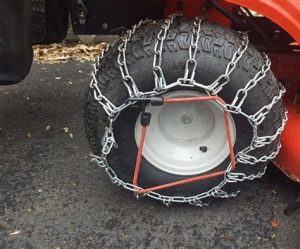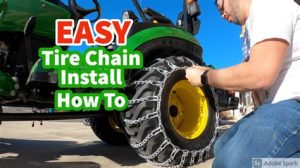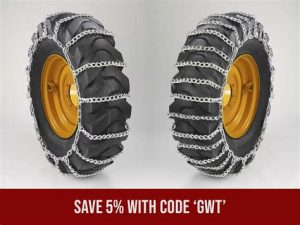Learn how to understand tire size, measure width and diameter, and choose the right chains with our comprehensive guide for optimal performance.When it comes to maintaining your tractor’s efficiency and ensuring its safety on various terrains, the right tire chains are essential. However, installing these chains requires precise measurements of your tractor’s tires to ensure a perfect fit. In this blog post, we will guide you through the steps to measure your tractor tires accurately, optimizing your setup for better traction and performance. We’ll start with understanding tire sizes, then move on to choosing the right chains that meet your needs. You’ll learn how to measure both the tire width and diameter, essential components for finding the correct chain size. Finally, we’ll discuss how to calculate the number of chains required for your tractor. Whether you’re facing winter conditions or rugged landscapes, this comprehensive guide will equip you with the knowledge to tackle the task confidently and effectively.
Understanding tire size
To effectively understand tire size, it is crucial to familiarize yourself with the alphanumeric codes found on the sidewalls of your tires. These codes indicate the tire’s width, aspect ratio, and diameter, which are essential for various applications, including traction and safety.
- P indicates passenger tire (for other types, such as truck or trailer, different prefixes may apply).
- xx is the width of the tire in millimeters.
- yy represents the aspect ratio, which is the height of the tire’s sidewall as a percentage of its width.
- zz is the diameter of the wheel in inches.
Additionally, it’s important to understand how tire size affects your vehicle’s performance. A wider tire offers greater traction, while an increased diameter can improve ground clearance and reduce rolling resistance.
Choosing the right chains
When it comes to ensuring optimal traction and safety while operating a tractor, selecting the right chains is crucial. The appropriate chains can make a significant difference, especially in adverse conditions such as snow, mud, or slippery terrain. There are various factors to consider when choosing chains for your tractor tires.
First, you should determine the size of your tractor tires. This includes both the width and diameter of the tires.
| Tire Size Measurement | Description |
|---|---|
| Width | The measurement across the tire from sidewall to sidewall. |
| Diameter | The measurement from one edge of the tire to the other, passing through the center. |
Next, consider the material of the chains. Most chains are made from steel, which offers durability and strength. However, there are also polymer options available that provide added protection for your tires and can prevent slipping. The choice between these materials often depends on the typical conditions in which you work. Additionally, ensure the chain’s link size is compatible with your tire size for a snug fit.
Finally, think about the style of the chains. Whether you prefer ladder chains, diagonal chains, or some other style, each type provides different levels of grip and stability. Ladder chains provide a solid surface area, while diagonal chains allow flexibility in movement. Assess your specific requirements and make an informed decision for optimal performance.
Measuring tire width
Measuring the width of your tractor tires is an essential step when preparing for chain installation. Knowing the exact tire width ensures that you select the right chains for optimal performance and safety.
- Locate the widest point of the tire, which is typically the sidewall.
- Use a measuring tape to measure from one side of the tire to the other, making sure to keep the tape level for accuracy.
- Record the measurement in inches or millimeters, depending on your preference.
It is important to note that tire width can vary between different models and types of tires. Always refer to your tire manufacturer’s specifications if available, and double-check your measurements to ensure that they match the dimensions needed for your chains.
Measuring tire diameter
Measuring the tire diameter is a crucial step when preparing for chain installation on your tractor. Accurately knowing the tire diameter ensures that you select the right chain size, which contributes to safer operations and improved performance.
To measure the tire diameter, you’ll need a measuring tape or a ruler.
- Ensure the tire is inflated to its recommended pressure.
- Measure from the top of the tire tread to the bottom of the tire on the opposite side.
- Record the measurement in inches or millimeters, depending on your preferred unit.
It’s important to note that different tire types may have varying diameters even if they share the same tire width. Therefore, always measure the exact tire you plan to use for chain installation.
Additionally, if you are measuring a tractor tire that has a heavy tread pattern or is somewhat irregular, it may be helpful to take several measurements across different sections of the tire and then calculate an average to obtain a more accurate diameter.
Once you have confirmed the tire diameter, this will greatly assist in ensuring that you purchase the correct chain size for effective and efficient use of your tractor.
Calculating chains needed
When it comes to ensuring your tractor operates efficiently, calculating the number of chains needed for your tires is essential. Using chains can provide additional traction in slippery conditions, but using the wrong number can lead to inefficiencies and potential damage.
To determine how many chains you’ll need, you first must know the tire size, which includes both the width and diameter of your tires. This information can usually be found in the tire specifications or on the sidewall of the tire itself. Once you have the tire dimensions, you can proceed to calculate the required chains.
The general rule of thumb for calculating chains is that one chain set typically includes two chains—one for the inner side of the tire and one for the outer.
| Formula | Description |
|---|---|
| Number of Chains = (Total Tire Circumference) / (Chain Length) | This formula allows you to calculate the number of chains needed based on the size of the tire and the length of the chains. |
Keep in mind that you may need to adjust the number of chains based on the type of terrain you will be working on. For instance, more chains may be necessary for icy or snowy conditions than for dry, firm ground.
Frequently Asked Questions
Why is it important to measure tractor tires before installing chains?
Measuring tractor tires ensures the chains fit correctly, providing optimal traction and preventing damage to the tires or chains during use.
What specific measurements are needed for tractor tires?
You need to measure the tire’s width, aspect ratio, and rim diameter to determine the appropriate chain size.
How can I accurately measure the width of my tractor tires?
Use a measuring tape to measure the distance across the tire from one side to the other at its widest point, ideally when the tire is mounted and inflated.
What is the aspect ratio, and how do I find it?
The aspect ratio is the height of the tire’s sidewall as a percentage of its width. It can typically be found on the tire’s sidewall marking.
Why is the rim diameter measurement crucial?
The rim diameter is vital because it determines the size of the tire and ensures that the chains fit the rim snugly and securely.
What tools do I need to measure tractor tires?
You’ll need a measuring tape or ruler, and possibly a notebook for recording measurements. A tire pressure gauge may also be helpful.
Can I use the same chains for different tire sizes?
No, chains are specifically designed for the size of the tire. Using the wrong size can lead to inefficient performance and potential safety hazards.





